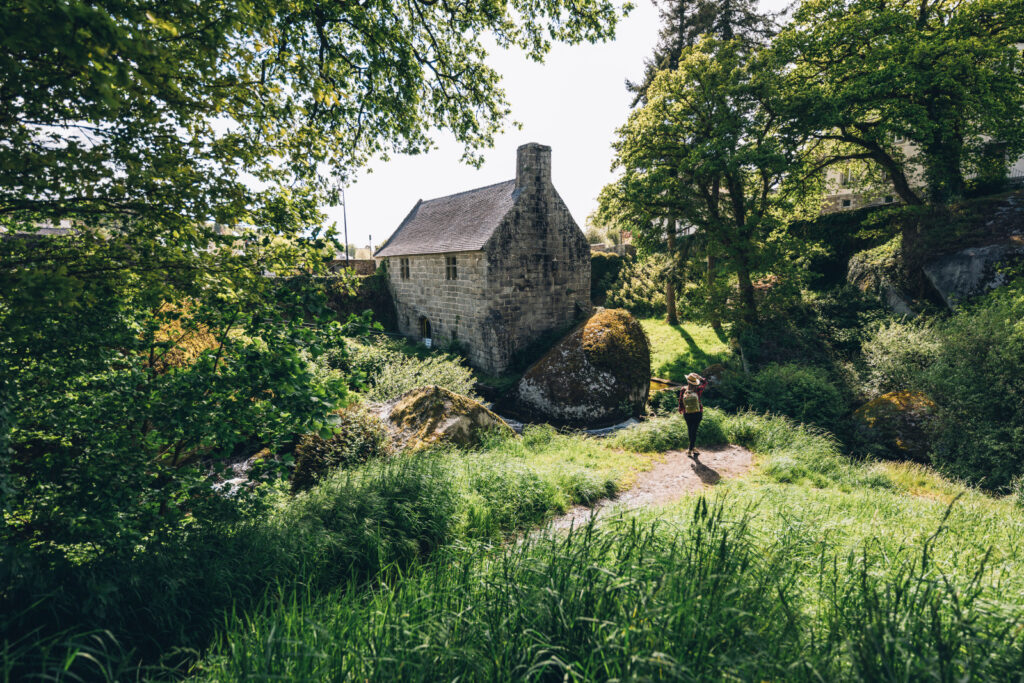
From a purely scientific point of view, the massive rocks in the forest of Huelgoat are the result of volcanic activity and thousands of years of erosion. But when you walk through the forest and take in its atmosphere, it’s easy to understand why early Bretons believed in a very different origin story.
According to legend, the giant Gargantua once lived in the forests at the heart of Brittany. He demanded food from the villagers of Huelgoat to satisfy his enormous hunger. One day, the villagers provoked his anger. The exact cause is unknown – perhaps they had spoiled him with too many Breton delicacies and failed to meet his high standards just once? Gargantua let his fury loose and bombarded the forest with massive stones.
Among the Stones of Huelgoat
Huelgoat lies on the southern edge of the vast “Parc Naturel Régional d’Armorique.” The nearest well-known town is Carhaix, with Morlaix being the closest larger city. Huelgoat itself is a charming little village nestled by a quiet lake. Everything in Huelgoat revolves around the famous forest and its legends. Even the names of restaurants and crêperies often reference elves, fairies, or trolls.
The Mill of Huelgoat
The lake’s water flows under a bridge at one end into a river. This “Silver River” (Rivière d’argent) gets its name from the nearby silver mines, where silver was extracted until the late 19th century.
Here, the water plunges steeply into a gorge, flanked by huge, moss-covered granite boulders. Towering above the ravine is an 800-year-old mill whose name, Moulin du Chaos (“Mill of Chaos”), perfectly captures the dramatic natural scene. Despite the chaotic appearance, the rocks seem to be in a delicate balance.
A legend also surrounds the river: Princess Dahut, daughter of the mythical King Gradlon, used the waters to drown her lovers after spending the night with them.

Sights Around Huelgoat
Opposite the mill, a hiking trail begins that leads to the main attractions around Huelgoat. At first, the trail is wide and even. But soon, hikers must squeeze through narrow rock crevices and descend steep steps. Unfortunately, the trail is not suitable for strollers or wheelchairs. Sturdy footwear is highly recommended – especially if the Breton weather doesn’t cooperate.
The small, wild stream soon disappears from view, and between the rocks, even its gentle bubbling fades. After a narrow passage, the view opens into another gorge. From there, the trail descends further into the Devil’s Grotto, a dark cave where the stream roars thunderously from the rocks. If hikers cross the boulders over the rushing water, the path leads to one of Huelgoat’s most fascinating attractions.
One Hundred Tons of Granite with One Hand?
The Trembling Rock (La Roche Tremblante) weighs over 100 tons, is 7 meters long and 3 meters high. The rock is positioned in such a way that, despite its weight, it can be moved by a person. If you press your shoulder against the right spot, the rock shifts a few centimeters to the side.
From the Trembling Rock, hikers return to the main path and come across the Virgin’s Household, a natural basin in the stream.
There, the path splits. One route continues along the peaceful stream, which now flows calmly after the wild chaos of rocks. Those who take the upper path, the Sentier des Amoureux (“Lovers’ Path”), soon reach Camp d’Artus. Whether the legendary King Arthur really camped here is unknown and likely to remain a mystery.
What is known, however, is that in 1938, archaeologists discovered the remains of a Gaulish settlement at this site. Until the 19th century, locals believed that demons haunted this place and guarded a hidden treasure. King Arthur also lends his name to the final stop on the forest trail: the Grotte d’Artus lies not far from the hill and is sheltered by a large rock overhang. From there, the trail leads back to the village of Huelgoat.
Top Campsites
Camping La Rivière d’Argent
A charming, unspoiled campsite by the river – perfect for hikers and nature lovers. Just minutes from Huelgoat, this peaceful green setting is ideal for those seeking relaxation in nature.
Camping Municipal de Huelgoat
A simple, quiet site located right next to the legendary Huelgoat forest—perfect for a tranquil getaway. Its central location makes the stunning rocks and hiking trails easily accessible on foot.
Camping de la Vallée de l’Hyères
Located a bit farther away in Carhaix-Plouguer, this well-equipped campsite offers a pool and direct access to hiking and biking trails. A great choice for families and active travelers who value both nature and comfort.
Camping Domaine de Mesqueau
A peaceful campsite with a pool and fishing opportunities, about 40 minutes from Huelgoat. Ideal for families and those seeking relaxation. The spacious grounds offer plenty of room and activities for all ages.
Foto: Comité Régional du Tourisme de Bretagne | © Teddy Verneuil
